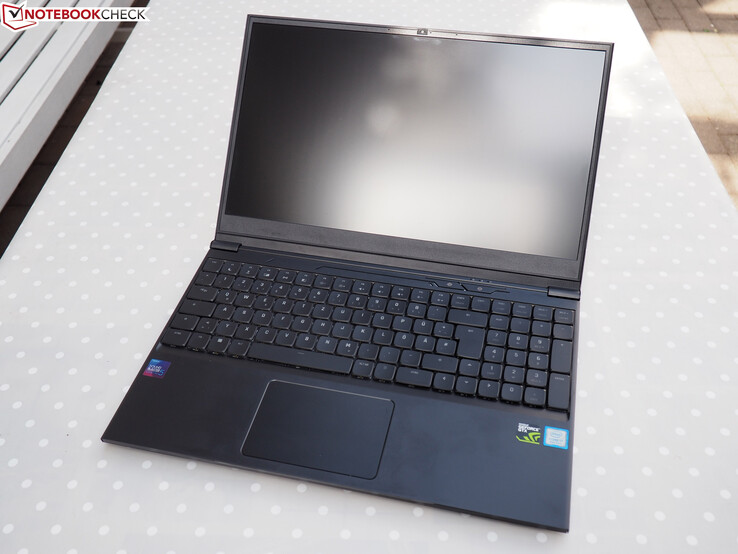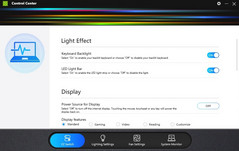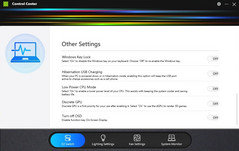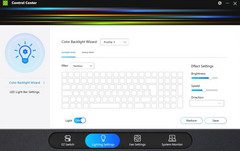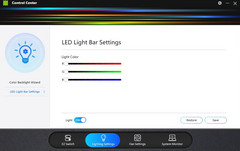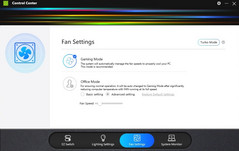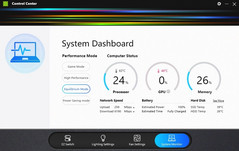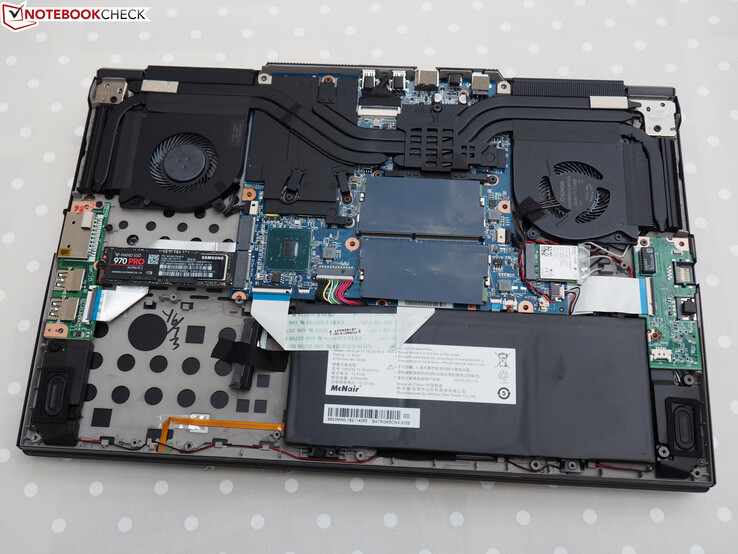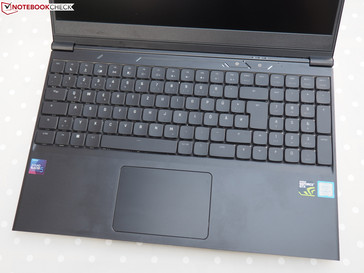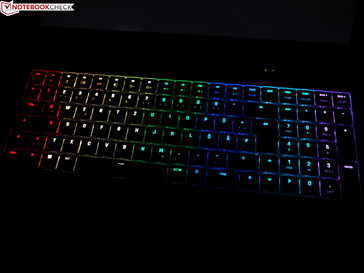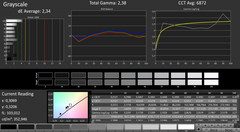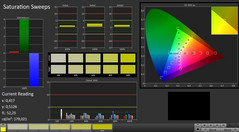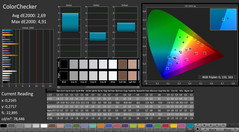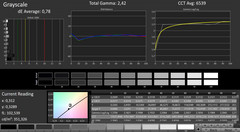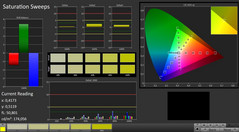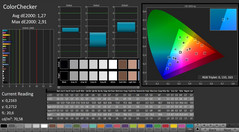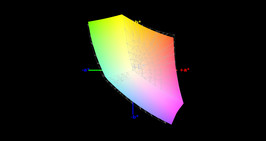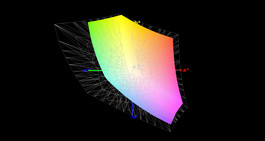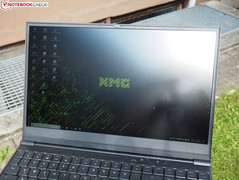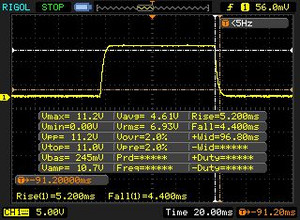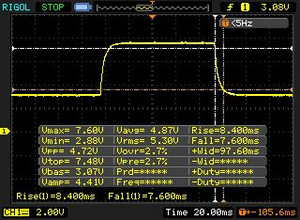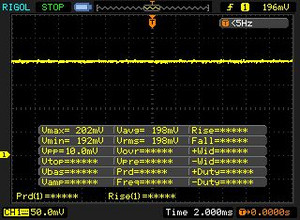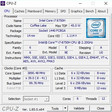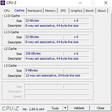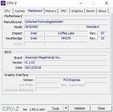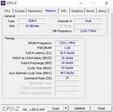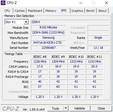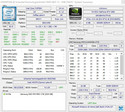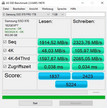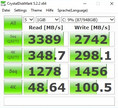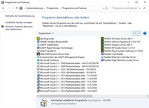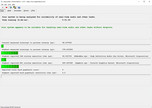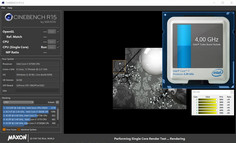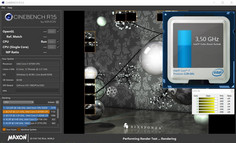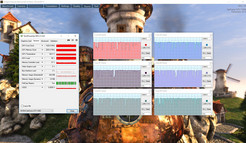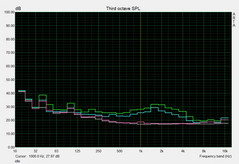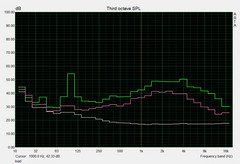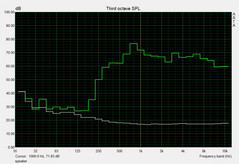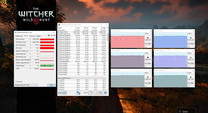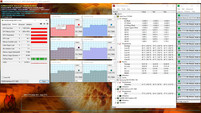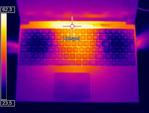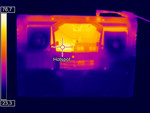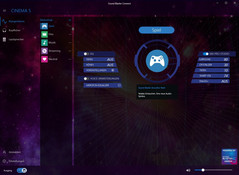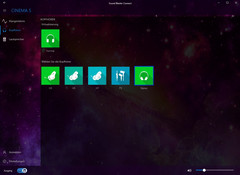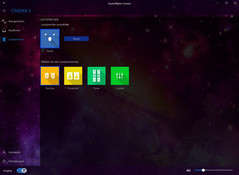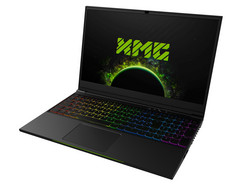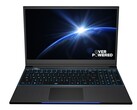Schenker XMG Neo 15 (i7-8750H, GTX 1060, Full HD, Tongfang GK5CN6Z) Laptop Review

Light and very slim high-end laptops are extremely popular right now. The German notebook retailer Schenker Technologies recognized this as well and now offers multiple slim gaming laptops.
While the recently reviewed Key 15 uses a conventional bezel width, the Neo 15 wants to impress with its Edge-to-Edge design. The 15.6-inch thin bezel screen runs at either 60 or 144 Hz (depending on the configuration on mysn.de). The mechanical RGB-keyboard is another highlight, but it is currently still limited to the German layout (other languages are supposed to follow).
You can customize both the RAM and the storage devices. The Neo 15 offers two DDR4-RAM slots (up to 32 GB), two M.2-2280 slots and one good old 2.5-inch slot, which unfortunately affects the size of the battery (only 46.7 Wh). Both the graphics card and the processor are soldered onto the motherboard, but Schenker still implements a conventional GTX 1060 and no Max-Q version despite the compact dimensions. A Core i7-8750H instead of the Core i5-8300H also appears to be a bit of a challenge for the cooling unit at first glance.
The Neo 15 starts at 1,399 Euros (~$1631), but you can easily increase the price with some upgrades. Our test model with 16 GB of RAM, 1 TB SSD, and Windows 10 Home, for example, costs more than 2,000 Euros (~$2332). Pre-configured models, which are available in some online shops (see price comparison at the end of the review), are much more affordable.
The list of competitors for the Neo 15 includes other 15-inch gamers with slim cases. As well as Schenker's own Key 15, we also compare the test device with the Asus GU501GM, Razer Blade 15, MSI GS65, and the Gigabyte Aero 15X. Can the Neo 15 secure a spot in our Top 10 ranking?
Case – Slim but still sturdy
While most Schenker laptops are based on Clevo designs, the Neo 15 uses a barebone chassis from the manufacturer Tongfang, more precisely the model GK5CN6Z. The latter does not have to hide behind its rivals, quite the contrary. This starts with the stability, which is on a very high level. It does not matter if you test the base unit or the lid, because the chassis does not warp even under a lot of pressure. The choice of materials deserves praise as well, only the bottom panel is primarily made of plastic, the rest is made of aluminum. The only drawback of the dark metal finish is the susceptibility to fingerprints.
Except for the edgy design and the giant fan exhausts at the bottom, the visual appearance is pretty simple. It is obviously a matter of taste, but we like it. You can see the gaming origins as soon as you boot the laptop. The RGB illumination for the keyboard is almost a matter of course, but you also get an LED strip on the front lighting up in different colors. There is not much to criticize about the build quality; most material transitions are very clean.
The Neo 15 leaves a good impression in our size comparison. With a footprint of 35.9 x 24.3 cm (~14.1 x 9.6 in), it is much more compact than the Key 15 (38.0 x 25.5 cm/~15 x 10 in). The Asus GU501GM is even bulkier at 38.4 x 26.2 cm (~15.1 x 10.3 in), while both the MSI GS65 and Gigabyte Aero 15X are a bit deeper yet slightly shorter in return. Only Razer's Blade 15 is smaller in every direction. The Neo 15 also holds up well when we compare the weight: About 2 kg (~4.4 lb) is easy to transport and only one rival here is lighter. It is a bit tricky to compare the height of the systems since the official specification does not include the rubber feet. With them, the Neo 15 is ~2.7 cm (~1.1 in) high instead of 2.2 cm (~0.87 in).
Connectivity – Where are the modern ports?
Ports
The port situation is a bit of a mixed bag. Three display outputs (1x HDMI + 2x DisplayPort) and four USB ports (3x Type-A + 1x Type-C) is a respectable selection for a gaming laptop, but potential buyers do not get Thunderbolt 3. USB 3.1 Gen 2 is not available either, which is pretty disappointing for a 2018 system. Two stereo jacks, the Kensington lock slot, and the foldable RJ45 port cannot fully compensate for this drawback. We think the port layout is decent, but the ports at the sides are pretty far to the front due to the position of the fan exhausts. This is not perfect when you want to use an external mouse (limited room when there are cables attached).
SD Card Reader
The performance of the card reader does not meet our expectations, and the Neo 15 is far from the PCIe speeds we know from the Key 15 or Aero 15X. Rates of 25-32 MB/s are USB 2.0 level, even though our reference card is capable of transfer speeds of up to 260 MB/s.
| SD Card Reader | |
| average JPG Copy Test (av. of 3 runs) | |
| Gigabyte Aero 15X v8 (Toshiba Exceria Pro SDXC 64 GB UHS-II) | |
| Schenker Key 15 Coffee Lake (Toshiba Exceria Pro SDXC 64 GB UHS-II) | |
| Average of class Gaming (20 - 210, n=66, last 2 years) | |
| Schenker XMG Neo 15 (Toshiba Exceria Pro SDXC 64 GB UHS-II) | |
| maximum AS SSD Seq Read Test (1GB) | |
| Gigabyte Aero 15X v8 (Toshiba Exceria Pro SDXC 64 GB UHS-II) | |
| Schenker Key 15 Coffee Lake (Toshiba Exceria Pro SDXC 64 GB UHS-II) | |
| Average of class Gaming (25.8 - 261, n=63, last 2 years) | |
| Schenker XMG Neo 15 (Toshiba Exceria Pro SDXC 64 GB UHS-II) | |
Communication
The Wi-Fi speed on the other hand is excellent: 665 Mbps on average (send) and 694 Mbps (receive) at a distance of 1 meter (~3 ft) to the router is excellent and the test model easily beats last-gen gaming systems. This is not surprising though when you consider the (optional) brand-new Killer Wireless-AC 1550, which supports all WLAN standards as well as Bluetooth 5.0.
| Networking | |
| iperf3 transmit AX12 | |
| Schenker Key 15 Coffee Lake | |
| Schenker XMG Neo 15 | |
| MSI GS65 8RF-019DE Stealth Thin | |
| Razer Blade 15 2018 | |
| Asus ROG GU501GM-BI7N8 | |
| Gigabyte Aero 15X v8 | |
| iperf3 receive AX12 | |
| Schenker XMG Neo 15 | |
| Schenker Key 15 Coffee Lake | |
| Gigabyte Aero 15X v8 | |
| Razer Blade 15 2018 | |
| Asus ROG GU501GM-BI7N8 | |
| MSI GS65 8RF-019DE Stealth Thin | |
Software
Modern gaming laptops are usually equipped with powerful tuning tools, and the Neo 15 is no exception. The so called Control Center has a very simple UI with lots of features divided into four different tabs. You can, for instance, adjust the keyboard illumination or the fan mode. The integrated system monitoring is handy as well. We performed all our benchmarks and measurements with the default setting, which uses the Gaming Mode for the fan control.
Accessories
Laptops from Schenker are usually shipped with numerous accessories, and buyers of the Neo 15 get a cleaning cloth, key chain, several stickers, a 2.5-inch frame, recovery DVD, and a USB thumb drive with drivers as well as the user manual. The power adapter (16.5 x 8 x 2.5 cm/~6.5 x 3.1 x 1 in) is rated at 180 W and tips the scale at 620 grams (~1.4 lb).
Maintenance
You need some patience if you want to maintain the Neo 15. The bottom panel is secured by 18 Philips screws, but there are no additional clips. Besides the RAM and storage slots that we have already mentioned, you can also access the battery, wireless module, and the cooling system consisting of two fans and multiple heat pipes.
Warranty
The base warranty includes a 24-month pickup & return service (with six-month quick repair), but you can upgrade the warranty period to 36 months. Please see our Guarantees, Return policies and Warranties FAQ for country-specific information.
Input Devices – Mechanical keyboard rocks!
Keyboard
One of the biggest highlights of the Schenker Neo 15 is the mechanical keyboard. This means that the typing noise is much louder compared to conventional keyboards, but the feedback is much more precise thanks to the firm pressure point or stroke, respectively. You also have to get used to the shape of the keys, because barebones manufacturer Tongfang decided to use a convex design, which reduces the key distances towards the center.
We like the layout, and the manufacturer has implemented a full-sized numeric keypad despite the limited space. Whether you appreciate the position of the arrow keys (between the main keyboard area and the number pad) is obviously a matter of taste. They are pretty big, so they are great for gaming. The high score for the keyboard is not just the result of the mechanics but is also for the powerful and multi-level illumination, which can be adjusted for each key individually. Several pre-defined modes are included as well.
Touchpad
The mouse replacement of the Neo 15 is a ClickPad without dedicated buttons. Its size is decent for a 15-inch system at around 10.5 x 7.5 cm. The gliding capabilities are decent thanks to the smooth finish, but there are touchpads with better gliding capabilities.
The Neo 15 supports multi-touch gestures, which is not surprising. Two-finger gestures such as scrolling or zooming work well. The precision of the touchpad is average. Both right and left clicks produce – similar to the keyboard – a pretty loud trigger sound. The mouse replacement is not directly underneath the space bar but is slightly shifted towards the right, so you do not need to deactivate it during gaming to avoid accidental inputs.
Display – The best combination
The optional 144 Hz panel is the right choice if you prefer a high refresh rate, and it is based on IPS technology, just like the regular 60 Hz screen. We think the 144 Hz screen pays off, even though some gamers might miss G-Sync support. Tongfang has decided to implement Nvidia's Optimus GPU-switching technology for improved battery runtimes instead, which makes sense considering the slim and light chassis.
| |||||||||||||||||||||||||
Brightness Distribution: 90 %
Center on Battery: 325 cd/m²
Contrast: 985:1 (Black: 0.33 cd/m²)
ΔE ColorChecker Calman: 2.69 | ∀{0.5-29.43 Ø4.78}
calibrated: 1.27
ΔE Greyscale Calman: 2.34 | ∀{0.09-98 Ø5}
94% sRGB (Argyll 1.6.3 3D)
60% AdobeRGB 1998 (Argyll 1.6.3 3D)
65.3% AdobeRGB 1998 (Argyll 3D)
94.1% sRGB (Argyll 3D)
64.3% Display P3 (Argyll 3D)
Gamma: 2.38
CCT: 6872 K
| Schenker XMG Neo 15 LGD05C0, IPS, 1920x1080 | Schenker Key 15 Coffee Lake LGD05C0, IPS, 1920x1080 | MSI GS65 8RF-019DE Stealth Thin AU Optronics B156HAN08.0 (AUO80ED), IPS, 1920x1080 | Gigabyte Aero 15X v8 LGD05C0, IPS, 1920x1080 | Razer Blade 15 2018 LGD05C0, IPS, 1920x1080 | Asus ROG GU501GM-BI7N8 AU Optronics AUO45ED, IPS, 1920x1080 | |
|---|---|---|---|---|---|---|
| Display | -1% | 1% | -1% | 0% | -4% | |
| Display P3 Coverage (%) | 64.3 | 63.4 -1% | 66.2 3% | 63.6 -1% | 64.3 0% | 63.4 -1% |
| sRGB Coverage (%) | 94.1 | 93.3 -1% | 92.1 -2% | 93.8 0% | 93.7 0% | 87.7 -7% |
| AdobeRGB 1998 Coverage (%) | 65.3 | 64.5 -1% | 67.2 3% | 64.9 -1% | 65.5 0% | |
| Response Times | -6% | -22% | -11% | -17% | -141% | |
| Response Time Grey 50% / Grey 80% * (ms) | 16 ? | 15.2 ? 5% | 17.6 ? -10% | 16.8 ? -5% | 17.2 ? -8% | 30.8 ? -93% |
| Response Time Black / White * (ms) | 9.6 ? | 11.2 ? -17% | 12.8 ? -33% | 11.2 ? -17% | 12 ? -25% | 27.6 ? -188% |
| PWM Frequency (Hz) | ||||||
| Screen | -5% | 1% | 16% | -6% | -18% | |
| Brightness middle (cd/m²) | 325 | 309 -5% | 254 -22% | 313 -4% | 290 -11% | 286.7 -12% |
| Brightness (cd/m²) | 303 | 291 -4% | 262 -14% | 300 -1% | 281 -7% | 281 -7% |
| Brightness Distribution (%) | 90 | 91 1% | 89 -1% | 78 -13% | 82 -9% | 92 2% |
| Black Level * (cd/m²) | 0.33 | 0.31 6% | 0.22 33% | 0.33 -0% | 0.3 9% | 0.39 -18% |
| Contrast (:1) | 985 | 997 1% | 1155 17% | 948 -4% | 967 -2% | 735 -25% |
| Colorchecker dE 2000 * | 2.69 | 2.96 -10% | 2.37 12% | 1.29 52% | 2.85 -6% | 4.17 -55% |
| Colorchecker dE 2000 max. * | 4.91 | 5.14 -5% | 4.71 4% | 2.04 58% | 6.27 -28% | 7.22 -47% |
| Colorchecker dE 2000 calibrated * | 1.27 | 1.41 -11% | 1.84 -45% | 1.39 -9% | ||
| Greyscale dE 2000 * | 2.34 | 2.88 -23% | 1.58 32% | 0.69 71% | 2.4 -3% | 2.5 -7% |
| Gamma | 2.38 92% | 2.33 94% | 2.48 89% | 2.43 91% | 2.34 94% | 2.274 97% |
| CCT | 6872 95% | 6725 97% | 6785 96% | 6550 99% | 6718 97% | 6885 94% |
| Color Space (Percent of AdobeRGB 1998) (%) | 60 | 60 0% | 60 0% | 60 0% | 60 0% | 57 -5% |
| Color Space (Percent of sRGB) (%) | 94 | 93 -1% | 92 -2% | 94 0% | 94 0% | 87 -7% |
| Total Average (Program / Settings) | -4% /
-4% | -7% /
-2% | 1% /
9% | -8% /
-6% | -54% /
-34% |
* ... smaller is better
The display measurements are on the expected level and the LGD05C0 is a very popular 144 Hz model also used by laptops such as the Schenker Key 15, Gigabyte Aero 15X, and Razer Blade 15. This 15.6-inch screen does not have any major drawbacks. It is an IPS panel with wide viewing angles that easily beat TN screens. Most buyers will also be happy with the color gamut: 94% sRGB and 60% AdobeRGB are completely sufficient for gaming and multimedia purposes.
The combination of usable brightness (~300 nits) and a decent black value (0.33) ensures a high contrast ratio of about 1,000:1. Our measurements also reveal good color accuracy with a pretty natural picture out of the box. A color cast is not visible.
Display Response Times
| ↔ Response Time Black to White | ||
|---|---|---|
| 9.6 ms ... rise ↗ and fall ↘ combined | ↗ 5.2 ms rise | |
| ↘ 4.4 ms fall | ||
| The screen shows fast response rates in our tests and should be suited for gaming. In comparison, all tested devices range from 0.1 (minimum) to 240 (maximum) ms. » 25 % of all devices are better. This means that the measured response time is better than the average of all tested devices (20.2 ms). | ||
| ↔ Response Time 50% Grey to 80% Grey | ||
| 16 ms ... rise ↗ and fall ↘ combined | ↗ 8.4 ms rise | |
| ↘ 7.6 ms fall | ||
| The screen shows good response rates in our tests, but may be too slow for competitive gamers. In comparison, all tested devices range from 0.165 (minimum) to 636 (maximum) ms. » 29 % of all devices are better. This means that the measured response time is better than the average of all tested devices (31.6 ms). | ||
Screen Flickering / PWM (Pulse-Width Modulation)
| Screen flickering / PWM not detected | |||
In comparison: 53 % of all tested devices do not use PWM to dim the display. If PWM was detected, an average of 8108 (minimum: 5 - maximum: 343500) Hz was measured. | |||
Performance – Serious gamer
Even though the Neo 15 only has the third most powerful GPU from Nvidia's Pascal series (without Max-Q design), you can classify the 15-inch laptop as a high-end gaming laptop. Our test model with the Core i7-8750H, 16 GB of DDR4-RAM and NVMe-SSD also handles any daily applications with ease.
Processor
The frequency of the 14 nm chip heavily depends on the utilization of the cores. Single-core applications are executed at up to 4.1 GHz, while the clock is limited to 3.9 GHz when you use all cores. The automatic Turbo Boost is very well utilized by the Neo 15, and it manages to secure the top spot in the Cinebench R15 Multi test. Other 8750H laptops are more than 5% slower.
| Cinebench R15 | |
| CPU Single 64Bit | |
| Average of class Gaming (188.8 - 343, n=143, last 2 years) | |
| Gigabyte Aero 15X v8 | |
| MSI GS65 8RF-019DE Stealth Thin | |
| Schenker Key 15 Coffee Lake | |
| Razer Blade 15 2018 | |
| Schenker XMG Neo 15 | |
| Asus ROG GU501GM-BI7N8 | |
| CPU Multi 64Bit | |
| Average of class Gaming (1537 - 6271, n=144, last 2 years) | |
| Asus ROG GU501GM-BI7N8 | |
| Schenker XMG Neo 15 | |
| Gigabyte Aero 15X v8 | |
| Schenker Key 15 Coffee Lake | |
| MSI GS65 8RF-019DE Stealth Thin | |
| Razer Blade 15 2018 | |
| Cinebench R11.5 | |
| CPU Single 64Bit | |
| Average of class Gaming (2.62 - 3.98, n=12, last 2 years) | |
| MSI GS65 8RF-019DE Stealth Thin | |
| Schenker Key 15 Coffee Lake | |
| Gigabyte Aero 15X v8 | |
| Schenker XMG Neo 15 | |
| Razer Blade 15 2018 | |
| Asus ROG GU501GM-BI7N8 | |
| CPU Multi 64Bit | |
| Average of class Gaming (10.4 - 70.7, n=12, last 2 years) | |
| Gigabyte Aero 15X v8 | |
| Schenker XMG Neo 15 | |
| Asus ROG GU501GM-BI7N8 | |
| Schenker Key 15 Coffee Lake | |
| MSI GS65 8RF-019DE Stealth Thin | |
| Razer Blade 15 2018 | |
The Neo 15 also performs well in our Cinebench loop. Instead of a massive drop after the first run, which was often the case for many Coffee Lake-H notebooks, the performance drop is small, which is an indicator for a good cooling unit.
System Performance
The overall system performance of the 15-inch laptop is also at the top of the comparison group. The Neo 15 can beat most of the direct rivals in PCMark 10; only the test model of the Schenker Key 15 gets a few points more. Windows 10 boots up very quickly thanks to the solid state drive, and application launches, installations or data transfers are much faster compared to conventional hard drives.
| PCMark 10 - Score | |
| Average of class Gaming (5776 - 9647, n=120, last 2 years) | |
| Schenker Key 15 Coffee Lake | |
| Schenker XMG Neo 15 | |
| MSI GS65 8RF-019DE Stealth Thin | |
| Asus ROG GU501GM-BI7N8 | |
| Gigabyte Aero 15X v8 | |
| Razer Blade 15 2018 | |
| PCMark 8 | |
| Home Score Accelerated v2 | |
| Average of class Gaming (5564 - 5883, n=2, last 2 years) | |
| MSI GS65 8RF-019DE Stealth Thin | |
| Razer Blade 15 2018 | |
| Schenker XMG Neo 15 | |
| Schenker Key 15 Coffee Lake | |
| Gigabyte Aero 15X v8 | |
| Asus ROG GU501GM-BI7N8 | |
| Work Score Accelerated v2 | |
| Schenker Key 15 Coffee Lake | |
| Gigabyte Aero 15X v8 | |
| Schenker XMG Neo 15 | |
| Razer Blade 15 2018 | |
| MSI GS65 8RF-019DE Stealth Thin | |
| Asus ROG GU501GM-BI7N8 | |
| Average of class Gaming (n=1last 2 years) | |
| PCMark 8 Home Score Accelerated v2 | 4585 points | |
| PCMark 8 Work Score Accelerated v2 | 5669 points | |
| PCMark 10 Score | 5191 points | |
Help | ||
Storage Devices
Schenker has equipped our test model with a giant 1 TB SSD from Samsung, which obviously increases the price significantly. The brand-new M.2 drive 970 Pro scores 5224 points in AS SSD, which is the best result we have ever seen during our reviews. CrystalDiskMark determines great results as well, but the less expensive Samsung 970 EVO performs on a very similar level (compare with the Schenker Key 15). The PCIe-SSDs of the competitors are only a bit slower; the only exception is the Asus ROG GU501GM.
| Schenker XMG Neo 15 Samsung SSD 970 Pro 1TB | Schenker Key 15 Coffee Lake Samsung SSD 970 EVO 500GB | MSI GS65 8RF-019DE Stealth Thin Samsung SSD PM981 MZVLB512HAJQ | Gigabyte Aero 15X v8 Toshiba NVMe THNSN5512GPU7 | Razer Blade 15 2018 Samsung PM961 NVMe MZVLW512HMJP | Asus ROG GU501GM-BI7N8 Kingston RBUSNS8154P3128GJ | |
|---|---|---|---|---|---|---|
| CrystalDiskMark 5.2 / 6 | 0% | -5% | -14% | -8% | -40% | |
| Read Seq Q32T1 (MB/s) | 3389 | 3549 5% | 2466 -27% | 2627 -22% | 3280 -3% | 1498 -56% |
| Write Seq Q32T1 (MB/s) | 2742 | 2498 -9% | 1919 -30% | 1375 -50% | 1527 -44% | 471.5 -83% |
| Read 4K Q32T1 (MB/s) | 348.7 | 376.8 8% | 353.7 1% | 332.8 -5% | 342.5 -2% | 342.2 -2% |
| Write 4K Q32T1 (MB/s) | 298.1 | 295.4 -1% | 309.9 4% | 268.6 -10% | 296.2 -1% | 264.8 -11% |
| Read Seq (MB/s) | 1278 | 1200 -6% | 1322 3% | 1404 10% | 1371 7% | 707 -45% |
| Write Seq (MB/s) | 1456 | 1466 1% | 1883 29% | 1335 -8% | 1483 2% | 469.5 -68% |
| Read 4K (MB/s) | 48.64 | 43.49 -11% | 40.13 -17% | 37.65 -23% | 39.23 -19% | 32.8 -33% |
| Write 4K (MB/s) | 100.5 | 113.5 13% | 95.3 -5% | 94.4 -6% | 94.2 -6% | 75.6 -25% |
GPU Performance
It is a bit of a mixed bag that Tongfang does not use the Max-Q version of the GTX 1060. This means that there are no compromises in terms of performance, but other areas such as the emissions, including the temperature and noise development, as well as the power consumption and battery runtime would have benefited.
| 3DMark - 1920x1080 Fire Strike Graphics | |
| Average of class Gaming (6487 - 62849, n=150, last 2 years) | |
| Razer Blade 15 2018 | |
| Gigabyte Aero 15X v8 | |
| MSI GS65 8RF-019DE Stealth Thin | |
| Schenker Key 15 Coffee Lake | |
| Asus ROG GU501GM-BI7N8 | |
| Schenker XMG Neo 15 | |
| 3DMark 11 - 1280x720 Performance GPU | |
| Average of class Gaming (13523 - 80022, n=137, last 2 years) | |
| Razer Blade 15 2018 | |
| Gigabyte Aero 15X v8 | |
| MSI GS65 8RF-019DE Stealth Thin | |
| Schenker Key 15 Coffee Lake | |
| Asus ROG GU501GM-BI7N8 | |
| Schenker XMG Neo 15 | |
Thanks to 6 GB of GDDR5-VRAM and 1280 shader units, the GeForce GTX 1060 can also handle demanding games. Slim gaming laptops can be even faster though, which is proven by the Schenker Key 15, MSI GS65, Razer Blade 15, and the Gigabyte Aero 15X. They are equipped with the GeForce GTX 1070 Max-Q, which manages between 22-36% more points in the 3DMark Fire Strike test.
| 3DMark 11 Performance | 13509 points | |
| 3DMark Cloud Gate Standard Score | 32771 points | |
| 3DMark Fire Strike Score | 10263 points | |
Help | ||
We checked the Turbo utilization of the GeForce GTX 1060 with the RPG game The Witcher 3 for one hour. Result: The base frequency is surpassed for the whole test and an average frequency of 1607 MHz is a very good result. The maximum clock of the DirectX 12 chip is up to 1900 MHz (GPU-Z render test).
Gaming Performance
The Neo 15 can handle games at the maximum details as long as you stick with the native 1080p resolution, but the 144 Hz is only fully utilized in less demanding titles such as Fortnite. More results above 100 FPS would require a GTX 1070 Max-Q, which would also offer more headroom for future games.
| The Witcher 3 - 1920x1080 Ultra Graphics & Postprocessing (HBAO+) | |
| Average of class Gaming (18.4 - 240, n=55, last 2 years) | |
| Razer Blade 15 2018 | |
| MSI GS65 8RF-019DE Stealth Thin | |
| Gigabyte Aero 15X v8 | |
| Schenker Key 15 Coffee Lake | |
| Schenker Key 15 Coffee Lake | |
| Asus ROG GU501GM-BI7N8 | |
| Schenker XMG Neo 15 | |
Core gamers will still be happy with the GTX 1060. The Witcher 3 performance is on par with the Asus GU501GM, which is also equipped with the GTX 1060, while the GTX 1070 Max-Q competition is 29-39% faster.
| low | med. | high | ultra | |
|---|---|---|---|---|
| The Witcher 3 (2015) | 71.7 | 38.6 | ||
| Fortnite (2018) | 110 | 84.4 | ||
| Final Fantasy XV Benchmark (2018) | 42 | |||
| Kingdom Come: Deliverance (2018) | 57.1 | 43 | ||
| Far Cry 5 (2018) | 68 | 64 | ||
| The Crew 2 (2018) | 60 | 59.9 |
Emissions – Preferably with headset
System Noise
The fan control is one of the biggest issues on most gaming laptops. The Neo 15 does not perform very well in this section either – it does not matter if you look at idle or load operation. There are basically two scenarios for idle operation: The fans are either completely turned off, so the 15-inch system is silent, or they murmur noticeably at 35-40 dB(A). It seems that there is no steady and more subtle level below that. The Clevo barebone chassis of the Schenker Key 15 suffers from the same problem.
The cooling gets annoyingly loud when you run 3D applications, and the Neo 15 basically forces you to use headphones at 50-58 dB(A) (53 dB(A) @The Witcher 3). Even loud devices such as the Asus GU501GM and the Gigabyte Aero 15X are in the range of up to 51 or 54 dB(A), respectively. The MSI GS65, Schenker Key 15, and Razer Blade 15 do not exceed the 50 dB(A) mark.
Maybe you can reduce the noise level with an adjustment of the fan mode in the Control Center (Office instead of Gaming), but this might have an effect on the performance as well. Tuning fans will also find a kind of manual mode in the software.
Note: Schenker has already sent us an update from Tongfang, which is supposed to improve the fan curve and reduce the noise development under load. We will update this review if the situation really improves.
Update: Unfortunately, the new BIOS/EC did not improve the situation; the determined noise levels were identical to our initial measurements.
Noise level
| Idle |
| 29 / 35 / 40 dB(A) |
| Load |
| 50 / 58 dB(A) |
 | ||
30 dB silent 40 dB(A) audible 50 dB(A) loud |
||
min: | ||
| Schenker XMG Neo 15 GeForce GTX 1060 Mobile, i7-8750H | Schenker Key 15 Coffee Lake GeForce GTX 1070 Max-Q, i7-8750H | MSI GS65 8RF-019DE Stealth Thin GeForce GTX 1070 Max-Q, i7-8750H | Gigabyte Aero 15X v8 GeForce GTX 1070 Max-Q, i7-8750H | Razer Blade 15 2018 GeForce GTX 1070 Max-Q, i7-8750H | Asus ROG GU501GM-BI7N8 GeForce GTX 1060 Mobile, i7-8750H | Average of class Gaming | |
|---|---|---|---|---|---|---|---|
| Noise | 3% | 11% | 5% | 8% | 7% | 16% | |
| off / environment * (dB) | 29 | 30 -3% | 30 -3% | 29 -0% | 29 -0% | 28.6 1% | 24.1 ? 17% |
| Idle Minimum * (dB) | 29 | 31 -7% | 30 -3% | 30 -3% | 29 -0% | 31.4 -8% | 26.1 ? 10% |
| Idle Average * (dB) | 35 | 37 -6% | 31 11% | 31 11% | 30 14% | 31.4 10% | 27.7 ? 21% |
| Idle Maximum * (dB) | 40 | 43 -8% | 34 15% | 35 12% | 38 5% | 34.2 14% | 30.2 ? 24% |
| Load Average * (dB) | 50 | 45 10% | 43 14% | 49 2% | 46 8% | 42.8 14% | 43 ? 14% |
| Witcher 3 ultra * (dB) | 53 | 46 13% | 42 21% | 51 4% | 49 8% | 50.9 4% | |
| Load Maximum * (dB) | 58 | 46 21% | 44 24% | 54 7% | 46 21% | 50.9 12% | 53.8 ? 7% |
* ... smaller is better
Temperature
The chassis warms up a lot under load, despite the high fan activity. Up to 56 °C (~133 °F) in the rear third of the top and up to 68 °C (~154 °F) at the metal cooling grilles at the bottom is quite a lot, even though other slim gaming laptops such as the Schenker key 15, MSI GS65, and the Gigabyte Aero 15X also exceed 60 °C (~1 40 °F) at some spots during our stress test with the tools FurMark and Prime95. We cannot recommend any of the mentioned devices for gaming sessions on your lap. Most spots of the Neo 15 stay comfortably cool while idling or under light workloads including office, video, and web tasks.
The components are not quite as cool. The CPU levels off at around 60-70 °C (~140-158 °F) after 60 minutes of The Witcher 3, but almost 90 °C (~194 °F) under maximum load is not a good result. Still, at least the i7-8750H does not throttle its performance even under extreme load. The situation is a bit different for the graphics chip. While the GeForce GTX 1060 warms up to about 70 °C (~158 °F) with active Turbo in The Witcher 3, the DirectX 12 chip throttles its performance to around 1190 MHz in the stress test. This is not necessary when you consider the average temperature of 77 °C (~171 °F).
(-) The maximum temperature on the upper side is 56 °C / 133 F, compared to the average of 40.4 °C / 105 F, ranging from 21.2 to 68.8 °C for the class Gaming.
(-) The bottom heats up to a maximum of 68 °C / 154 F, compared to the average of 43.3 °C / 110 F
(+) In idle usage, the average temperature for the upper side is 27.2 °C / 81 F, compared to the device average of 33.9 °C / 93 F.
(-) Playing The Witcher 3, the average temperature for the upper side is 41.6 °C / 107 F, compared to the device average of 33.9 °C / 93 F.
(-) The palmrests and touchpad can get very hot to the touch with a maximum of 41 °C / 105.8 F.
(-) The average temperature of the palmrest area of similar devices was 28.9 °C / 84 F (-12.1 °C / -21.8 F).
| Schenker XMG Neo 15 GeForce GTX 1060 Mobile, i7-8750H | Schenker Key 15 Coffee Lake GeForce GTX 1070 Max-Q, i7-8750H | MSI GS65 8RF-019DE Stealth Thin GeForce GTX 1070 Max-Q, i7-8750H | Gigabyte Aero 15X v8 GeForce GTX 1070 Max-Q, i7-8750H | Razer Blade 15 2018 GeForce GTX 1070 Max-Q, i7-8750H | Asus ROG GU501GM-BI7N8 GeForce GTX 1060 Mobile, i7-8750H | Average of class Gaming | |
|---|---|---|---|---|---|---|---|
| Heat | -8% | 12% | 3% | -6% | 8% | 5% | |
| Maximum Upper Side * (°C) | 56 | 57 -2% | 49 12% | 53 5% | 56 -0% | 43 23% | 45.6 ? 19% |
| Maximum Bottom * (°C) | 68 | 65 4% | 63 7% | 65 4% | 59 13% | 46.6 31% | 48.3 ? 29% |
| Idle Upper Side * (°C) | 28 | 33 -18% | 24 14% | 26 7% | 33 -18% | 29.2 -4% | 31.4 ? -12% |
| Idle Bottom * (°C) | 29 | 33 -14% | 25 14% | 30 -3% | 34 -17% | 34 -17% | 34.3 ? -18% |
* ... smaller is better
Speakers
Potential buyers should not expect too much from the speakers. As with almost all slim gaming laptops, the Neo 15 hardly offers any bass. Our speaker analysis also shows that the mids could be better. Subjectively, the sound is pretty tinny, muddy and undifferentiated. The maximum volume is not very high either.
You can at least customize the sound a bit thanks to the preloaded Sound Blaster Connect software, which includes several profiles and sound improvements.
Schenker XMG Neo 15 audio analysis
(±) | speaker loudness is average but good (81 dB)
Bass 100 - 315 Hz
(-) | nearly no bass - on average 26.2% lower than median
(±) | linearity of bass is average (12.9% delta to prev. frequency)
Mids 400 - 2000 Hz
(+) | balanced mids - only 4.8% away from median
(±) | linearity of mids is average (7.4% delta to prev. frequency)
Highs 2 - 16 kHz
(+) | balanced highs - only 2.6% away from median
(+) | highs are linear (6.4% delta to prev. frequency)
Overall 100 - 16.000 Hz
(±) | linearity of overall sound is average (21.8% difference to median)
Compared to same class
» 78% of all tested devices in this class were better, 6% similar, 17% worse
» The best had a delta of 6%, average was 18%, worst was 132%
Compared to all devices tested
» 61% of all tested devices were better, 7% similar, 32% worse
» The best had a delta of 4%, average was 24%, worst was 134%
Schenker Key 15 Coffee Lake audio analysis
(±) | speaker loudness is average but good (76 dB)
Bass 100 - 315 Hz
(-) | nearly no bass - on average 26.7% lower than median
(±) | linearity of bass is average (10.8% delta to prev. frequency)
Mids 400 - 2000 Hz
(±) | higher mids - on average 5.7% higher than median
(±) | linearity of mids is average (9.6% delta to prev. frequency)
Highs 2 - 16 kHz
(+) | balanced highs - only 1.4% away from median
(+) | highs are linear (3.8% delta to prev. frequency)
Overall 100 - 16.000 Hz
(±) | linearity of overall sound is average (24.6% difference to median)
Compared to same class
» 88% of all tested devices in this class were better, 4% similar, 8% worse
» The best had a delta of 6%, average was 18%, worst was 132%
Compared to all devices tested
» 74% of all tested devices were better, 6% similar, 20% worse
» The best had a delta of 4%, average was 24%, worst was 134%
Energy Management – Small battery
Power Consumption
Nvidia's Optimus technology, which reserves the GeForce GTX 1060 for demanding scenarios, ensures moderate consumption figures while idling and during light workloads thanks to the integrated graphics adapter of the processor (UHD Graphics 630). 10-18 W is efficient for a gaming laptop when you exclude the occasional peaks. Our load measurements determine between 95 and 179 W for the Neo 15, which could also be the result of a GTX 1070 Max-Q laptop.
| Off / Standby | |
| Idle | |
| Load |
|
Key:
min: | |
| Schenker XMG Neo 15 GeForce GTX 1060 Mobile, i7-8750H | Schenker Key 15 Coffee Lake GeForce GTX 1070 Max-Q, i7-8750H | MSI GS65 8RF-019DE Stealth Thin GeForce GTX 1070 Max-Q, i7-8750H | Gigabyte Aero 15X v8 GeForce GTX 1070 Max-Q, i7-8750H | Razer Blade 15 2018 GeForce GTX 1070 Max-Q, i7-8750H | Asus ROG GU501GM-BI7N8 GeForce GTX 1060 Mobile, i7-8750H | Average of class Gaming | |
|---|---|---|---|---|---|---|---|
| Power Consumption | -17% | 2% | -20% | -19% | -19% | -39% | |
| Idle Minimum * (Watt) | 10 | 14 -40% | 7 30% | 14 -40% | 14 -40% | 12.35 -24% | 13.6 ? -36% |
| Idle Average * (Watt) | 13 | 17 -31% | 11 15% | 18 -38% | 17 -31% | 19.98 -54% | 19.5 ? -50% |
| Idle Maximum * (Watt) | 18 | 22 -22% | 20 -11% | 22 -22% | 21 -17% | 25.44 -41% | 26.1 ? -45% |
| Load Average * (Watt) | 95 | 102 -7% | 98 -3% | 91 4% | 95 -0% | 94.28 1% | 110.9 ? -17% |
| Witcher 3 ultra * (Watt) | 114 | 130 -14% | 132 -16% | 142 -25% | 141 -24% | 132.9 -17% | |
| Load Maximum * (Watt) | 179 | 157 12% | 182 -2% | 173 3% | 179 -0% | 140.63 21% | 262 ? -46% |
* ... smaller is better
Battery Runtime
The battery runtime is neither particularly good nor bad. Our Wi-Fi test determines 4:22 hours, so the 15-inch system is ahead of the Schenker Key 15 and the Asus GU501GM, but it cannot keep up with the Razer Blade 15 (5:22 hours), MSI GS65 (6:02 hours), and Gigabyte Aero 15X (8:33 hours). The situation is similar in the video test at an adjusted luminance. The maximum runtime under perfect conditions (idle, minimum luminance) is 6:40 hours, while the minimum runtime under stress (maximum luminance) is 1:51 hours. We hope the successor gets a bigger battery; 46.7 Wh is not much compared to some rivals.
| Schenker XMG Neo 15 GeForce GTX 1060 Mobile, i7-8750H, 46.7 Wh | Schenker Key 15 Coffee Lake GeForce GTX 1070 Max-Q, i7-8750H, 55 Wh | MSI GS65 8RF-019DE Stealth Thin GeForce GTX 1070 Max-Q, i7-8750H, 82 Wh | Gigabyte Aero 15X v8 GeForce GTX 1070 Max-Q, i7-8750H, 94.24 Wh | Razer Blade 15 2018 GeForce GTX 1070 Max-Q, i7-8750H, 80 Wh | Asus ROG GU501GM-BI7N8 GeForce GTX 1060 Mobile, i7-8750H, 55 Wh | Average of class Gaming | |
|---|---|---|---|---|---|---|---|
| Battery runtime | -21% | 15% | 74% | -1% | -33% | 37% | |
| Reader / Idle (h) | 6.7 | 5 -25% | 8.5 27% | 12.7 90% | 6.4 -4% | 4.5 -33% | 9.99 ? 49% |
| H.264 (h) | 4.8 | 5.9 23% | 8.4 75% | 5.4 13% | 8.1 ? 69% | ||
| WiFi v1.3 (h) | 4.4 | 3.7 -16% | 6 36% | 8.6 95% | 5.4 23% | 4 -9% | 6.76 ? 54% |
| Load (h) | 1.9 | 1.5 -21% | 1.4 -26% | 2.6 37% | 1.2 -37% | 0.8 -58% | 1.435 ? -24% |
Verdict – Fight for the top spot
Pros
Cons
The XMG Neo 15 can compete at the top of the highly competitive market of slim gaming laptops but cannot quite beat the current leaders Gigabyte Aero 15X (88%) and Razer Blade 15 (87%).
The overall impression is more on par with the MSI GS65 (86%) or Asus ROG GU501GM (85%), respectively.
Positive aspects include the very compact and surprisingly sturdy metal chassis, which – except for Thunderbolt 3 or USB 3.1 Gen.2 – offers plenty of ports as well as a mechanical keyboard (with RGB illumination). The latter is a real purchase argument and lifts the Neo 15 above the competition.
We also like the display: The combination of IPS technology, 144 Hz and thin bezel design is almost everything you expect from an expensive laptop in 2018.
There are also some drawbacks, like the speaker quality and the emissions (temperature, noise development). The Neo 15 not only gets pretty warm under load but is also very loud. Barebone manufacturer Tongfang should also work on the fan control while idling and the battery capacity, which should at least be around 70 Wh for better mobility.
Schenker XMG Neo 15
- 05/14/2020 v7 (old)
Florian Glaser




